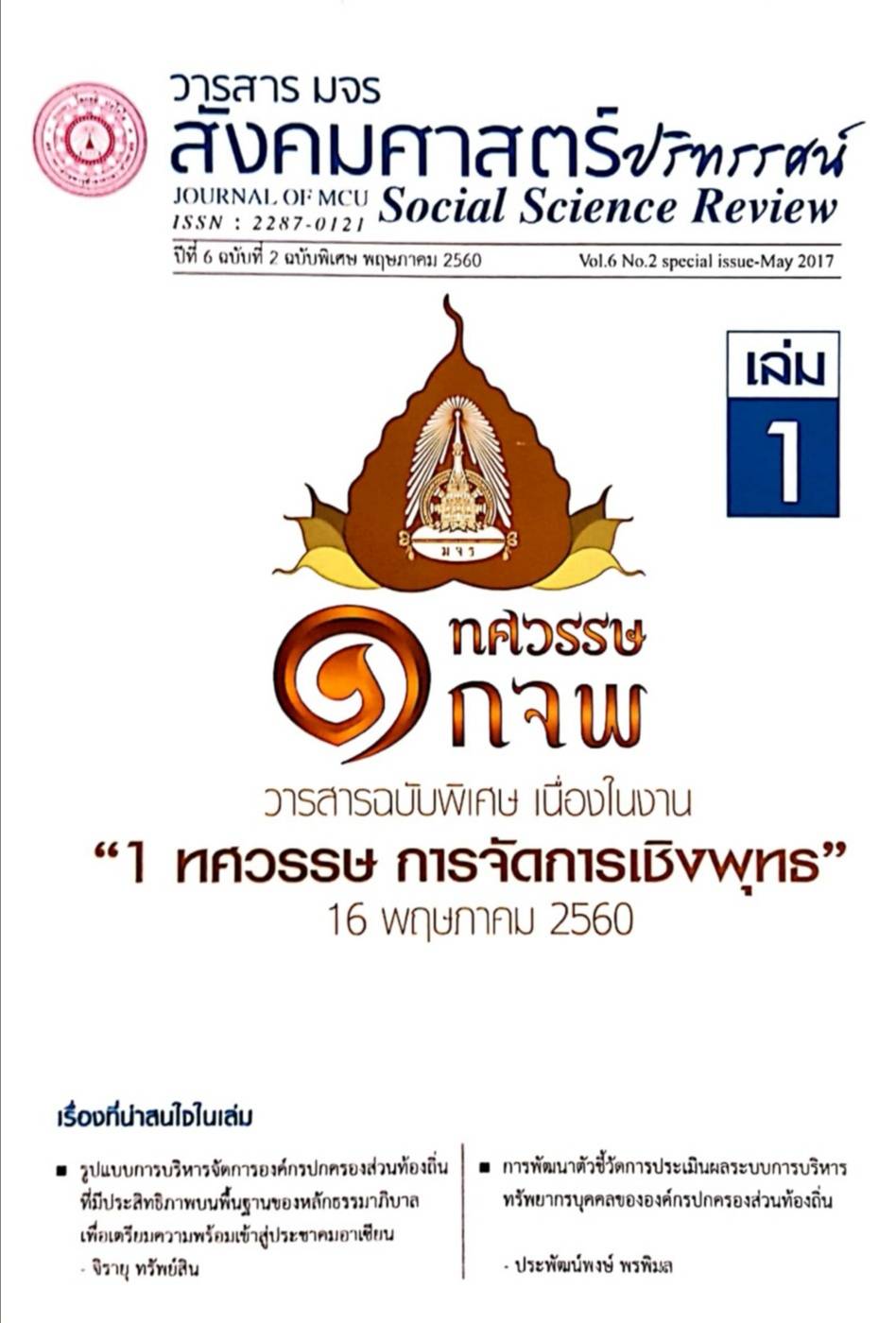รูปแบบการตลาดของร้านค้าปลีกแบบดั้งเดิม ในเขตกรุงเทพมหานครและปริมณฑล การเปลี่ยนแปลงพฤติกรรมผู้บริโภคในการขยายตัวของธุรกิจค้าปลีกสมัยใหม่
คำสำคัญ:
รูปแบบ, การตลาด, ร้านค้าปลีกแบบดั้งเดิมบทคัดย่อ
การวิจัยครั้งนี้มีวัตถุประสงค์ (1) เพื่อศึกษาองค์ประกอบการตลาด พฤติกรรมของผู้บริโภค และประสิทธิภาพการตลาดของธุรกิจค้าปลีกแบบดั้งเดิมในเขตกรุงเทพมหานครและ
ปริมณฑล เพื่อรองรับการเปลี่ยนแปลงพฤติกรรมผู้บริโภคในการขยายตัวของธุรกิจค้าปลีกสมัยใหม่ (2) เพื่อศึกษาหาความสัมพันธ์การตลาด พฤติกรรมของผู้บริโภค และประสิทธิภาพการตลาดที่มีผล
ต่อธุรกิจค้าปลีกแบบดั้งเดิมในเขตกรุงเทพมหานครและปริมณฑล เพื่อรองรับการเปลี่ยนแปลง พฤติกรรมผู้บริโภคในการขยายตัวของธุรกิจค้าปลีกสมัยใหม่ (3) เพื่อนำเสนอรูปแบบการตลาดของ
ธุรกิจค้าปลีกแบบดั้งเดิม ในเขตกรุงเทพมหานครและปริมณฑล เพื่อรองรับการเปลี่ยนแปลง พฤติกรรมผู้บริโภคในการขยายตัวของธุรกิจค้าปลีกสมัยใหม่
ผู้วิจัยใช้กรอบแนวคิดและทฤษฏีการตลาด พฤติกรรมผู้บริโภค และความพึงพอใจ ความจงรักภักดี ภาพลักษณ์ รูปแบบของการวิจัยใช้ทั้งเชิงปริมาณและเชิงภาพคุณ เครื่องมือที่ใช้เก็บ
ข้อมูลได้แก่ การวิจัยเชิงปริมาณ คือ ประชากรในเขตกรุงเทพมหานครและปริมณฑลที่เคยใช้บริการซื้อสินค้าในธุรกิจค้าปลีกแบบดั้งเดิม จำนนวน 400 คน วิเคราะห์ข้อมูลด้วยโปรแกรมคอมพิวเตอร์
สำเร็จรูป สถิติเชิงพรรณนาของข้อมูลตัวแปรอิสระ ตัวแปรแทรก ต้วแปลผล และหาความสัมพันธ์ตามข้อสมมติฐานของการวิจัยด้วยค่าสัมประสิทธิ์สหพันธ์แบบเพียร์สัน (Pearson correlation)
การวิเคราะห์ข้อมูลสถิติ Factor Analysis และการวิจัยเชิงคุณภาพ คือ ผู้ประกอบร้านปลีกแบบดั้งเดิมในเขตกรุงเทพมหานครและปริมณฑล จานวน 10 คน
ผลการวิจัยพบว่า
1) การตลาดในภาพรวมมีระดับความคิดเห็นมาก เมื่อพิจารณาเป็นรายด้านพบว่าด้านผลิตภัณฑ์มีระดับความคิดเห็นมาก พฤติกรรมของผู้บริโภคในภาพรวมมีระดับความคิดเห็นปาน
กลาง เมื่อพิจารณาเป็นรายด้านพบว่าด้านทัศนคติมีระดับความคิดเห็นมาก และประสิทธิภาพการตลาดในภาพรวมมีระดับความคิดเห็นมาก เมื่อพิจารณาเป็นรายด้านพบว่าด้านความพึงพอใจมี
ระดับความคิดเห็นมาก
2) การตลาดมีความสัมพันธ์กับพฤติกรรมของผู้บริโภค อย่างมีนัยสำคัญทางสถิติที่ 0.1 การตลาดมีความสัมพันธ์กับประสิทธิภาพของการตลาด อย่างมีนัยสาคัญทางสถิติที่ 0.1 และ
พฤติกรรมของผู้บริโภคมีความสัมพันธ์กับประสิทธิภาพของการตลาด อย่างมีนัยสาคัญทางสถิติที่ 0.1
3) องค์ประกอบเชิงยืนยันเพื่อสร้างรูปแบบ พบว่าการตลาดประกอบด้วย 1) ด้านทาเล ที่ตั้ง 2) ด้านราคา 3) ด้านลักษณะทางกายภาพ 4) ด้านผลิตภัณฑ์ 5) ด้านส่งเสริมการตลาด
พฤติกรรมของผู้บริโภคประกอบด้วย 1) ด้านแรงจูงใจ 2) ด้านทัศนคติ 3) ด้านการรับรู้ และประสิทธิภาพของการตลาดประกอบด้วย 1) ด้านความจงรักภักดี 2) ด้านภาพลักษณ์ 3) ด้านความ
พึงพอใจ
เอกสารอ้างอิง
กระทรวงพาณิชย์. (2542). การค้าส่งค้าปลีกไทย (รายงานทิศทางเศรษฐกิจและการค้าไทย: ภาค
การค้าภาคในประเทศ). ฝ่ายวิจัยการเศรษฐกิจรายสาขา. สถาบันวิจัยเพื่อพัฒนาประเทศ
กระทรวงพาณิชย์.
กระทรวงพาณิชย์. (2552). สานักส่งเสริมการแข่งขันทางการค้า กรมการค้าภายใน. รายงานการ
ขยายสาขาของธุรกิจค้าปลีกสมัยใหม่. กรุงเทพฯ.
ขุน วิจิตรมาตรา. (2516). ประวัติการค้าไทย. พิมพ์ครั้งที่ 4. กรุงเทพฯ : รวมสาส์น.
ธนาคารทหารไทย. (2547). ธุรกิจค้าปลีกแนวดน้มยังแข่งขันสูง. กรุงเทพฯ: เศรษฐกิจสนเทศ.
ธนาคารแห่งประเทศไทย. (2554). สถิติเศรษฐกิจและการเงิน. กรุงเทพฯ : ธนาคารแห่ง
ประเทศไทย.
ศรีสุภา สหชัยเสรี. (2538). การตลาด กลไกสู่โลกกว้าง. กรุงเทพฯ : ชวนพิมพ์
ศิริวรรณ เสรีรัตน์, ปริญ ลักษิตานนท์, ศุภร เสรีรัตน์ และองอาจ ปทะวานิช. (2541). กลยุทธ์
การตลาด: การบริหารการตลาด และกรณีตัวอย่าง. กรุงเทพฯ: ธีระฟิล์ม และไซเท็กซ์,
สถาบันวิจัยเพื่อการพัฒนาประเทศไทย. (2549). การค้าปลีกของไทย. ผลกระทบของการแข่งขัน
ผู้ประกอบการค้าปลีกขนาดใหญ่จากต่างประเทศ.
สมพร สุทัศนีย์. (2542). มนุษยสัมพันธ์. กรุงเทพฯ: จุฬาลงกรณ์มหาวิทยาลัย.
อธิวัฒน์ ทรัพย์ไพฑูรย์. (2545). อภิมหาอาณาจักรธุรกิจค้าปลีกค้าส่ง. กรุงเทพฯ : พึ่งตน
อนุศาสตร์ สระทองเวียน. (2553). ธุรกิจค้าปลีกประเทศไทย Retail Business in Thailand.
กรุงเทพฯ : วารสารนักบริหาร.
Kotler, P. (1999). Kotler on marketing: How to create, win and dominate markets.
New York : Free Press, 2004.
Lovelock C. and Wrigth L. ,(2008). Principles of service marketing and management.
2 th ed. Upper Saddle River, NJ : Prentice Hall
Warlop L. Ratneshwar, S., van Osselaer, & S.M.J. Distinctive brand cues and memory
for product consumption experiences. Intern. [Journal of Research in
Marketing : 2005].
ดาวน์โหลด
เผยแพร่แล้ว
รูปแบบการอ้างอิง
ฉบับ
ประเภทบทความ
สัญญาอนุญาต
ลิขสิทธิ์ (c) 2020 วารสาร มจร สังคมศาสตร์ปริทรรศน์

อนุญาตภายใต้เงื่อนไข Creative Commons Attribution-NonCommercial-NoDerivatives 4.0 International License.
เพื่อให้เป็นไปตามกฎหมายลิขสิทธิ์ ผู้นิพนธ์ทุกท่านต้องลงลายมือชื่อในแบบฟอร์มใบมอบลิขสิทธิ์บทความให้แก่วารสารฯ พร้อมกับบทความต้นฉบับที่ได้แก้ไขครั้งสุดท้าย นอกจากนี้ ผู้นิพนธ์ทุกท่านต้องยืนยันว่าบทความต้นฉบับที่ส่งมาตีพิมพ์นั้น ได้ส่งมาตีพิมพ์เฉพาะในวารสาร มจร สังคมศาสตร์ปริทรรศน์ เพียงแห่งเดียวเท่านั้น หากมีการใช้ภาพหรือตารางหรือเนื้อหาอื่นๆ ของผู้นิพนธ์อื่นที่ปรากฏในสิ่งตีพิมพ์อื่นมาแล้ว ผู้นิพนธ์ต้องขออนุญาตเจ้าของลิขสิทธิ์ก่อน พร้อมทั้งแสดงหนังสือที่ได้รับการยินยอมต่อบรรณาธิการ ก่อนที่บทความจะได้รับการตีพิมพ์ หากไม่เป็นไปตามข้อกำหนดเบื้องต้น ทางวารสารจะถอดบทความของท่านออกโดยไม่มีข้อยกเว้นใดๆ ทั้งสิ้น





